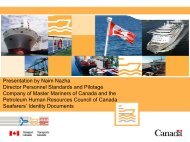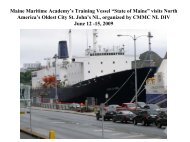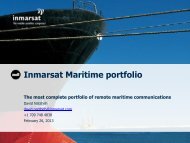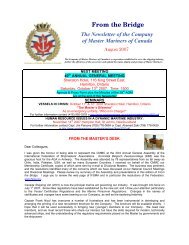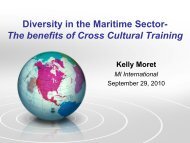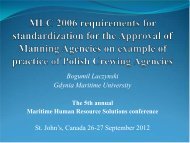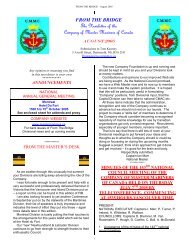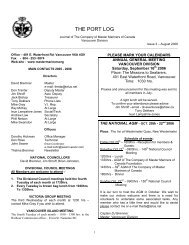From the Bridge - Company of Master Mariners of Canada
From the Bridge - Company of Master Mariners of Canada
From the Bridge - Company of Master Mariners of Canada
Create successful ePaper yourself
Turn your PDF publications into a flip-book with our unique Google optimized e-Paper software.
“<strong>From</strong> <strong>the</strong> <strong>Bridge</strong>” August 2009 www.mastermariners.ca<br />
required (in <strong>the</strong> winter months this service operates overnight with a stop at Bella Bella en route). Because <strong>of</strong> <strong>the</strong> early<br />
hour <strong>the</strong> cafeteria was not yet open but refreshments were provided in <strong>the</strong> foyer on Deck 4.<br />
Just before 0730 <strong>the</strong> vessel backed away from its berth. Few people were<br />
about to see us depart but many bald eagles were watching us. The ship<br />
turned and was soon making its way out <strong>of</strong> Port Hardy to pass by some small<br />
islands and into <strong>the</strong> nor<strong>the</strong>rn end <strong>of</strong> Queen Charlotte Strait. At that point we<br />
were exposed to <strong>the</strong> swells <strong>of</strong> <strong>the</strong> North Pacific. We were warned that <strong>the</strong><br />
vessel might roll however <strong>the</strong>re was very little movement in <strong>the</strong> ship on that<br />
day. After about two hours we entered sheltered waters once more.<br />
The numerals on <strong>the</strong> BC Ferries chart indicate points <strong>of</strong> interest. We were<br />
northbound so our first point was #6, Namu. Namu is a First Nations word<br />
meaning “whirlwind”. It is <strong>the</strong> oldest settlement on <strong>the</strong> coast featuring a<br />
cannery that operated from 1893 to 1970. Anchorage in <strong>the</strong> bay is not<br />
recommended during autumn months when winds known as “williwaws”,<br />
sudden, violent, katabatic gusts <strong>of</strong> wind, descend from nearby mountains.<br />
Point #5 was reached after five hours. This is <strong>the</strong> community <strong>of</strong> Bella Bella. It<br />
is one <strong>of</strong> <strong>the</strong> largest First Nations communities on <strong>the</strong> coast. Fishing and<br />
logging have made <strong>the</strong> place prosperous. #4 is Boat Bluff. Established in<br />
1907 it is perhaps <strong>the</strong> most scenic <strong>of</strong> lighthouses along <strong>the</strong> Inside Passage. It<br />
is situated on <strong>the</strong> sou<strong>the</strong>rn end <strong>of</strong> Sarah Island. The light marked our<br />
entrance into Tolmie Channel.<br />
Boat Bluff is at <strong>the</strong> mid point <strong>of</strong> <strong>the</strong> voyage. Although our day was overcast<br />
and we could not see mountains, <strong>the</strong> scenery was always spectacular. The<br />
shoreline was close on both<br />
sides <strong>of</strong> <strong>the</strong> vessel. Luckily<br />
<strong>the</strong>re was little or no rain so it<br />
was very comfortable when out<br />
on deck. Officers on <strong>the</strong> bridge<br />
made announcements<br />
whenever whales had been<br />
sighted. This always sent<br />
passengers scurrying to port or<br />
starboard to catch a glimpse.<br />
There were humpback whales<br />
and orcas. We saw dolphins<br />
too.<br />
Point <strong>of</strong> interest #3 is Swanson<br />
Bay. Not much can be seen <strong>of</strong> what was one <strong>of</strong> <strong>the</strong> first sulphite pulp mills on<br />
<strong>the</strong> coast. It was established in 1909. At this point we still had 5½ hours left<br />
before we would reach our destination. But we were relaxed and comfortable,<br />
and we had no complaints about <strong>the</strong> meals we had enjoyed.<br />
We passed #2 a short time later. This is Butedale on Princess Royal Island. It was established in 1918 as a fishing,<br />
mining and logging area.<br />
The #1 point <strong>of</strong> interest is <strong>the</strong> Grenville Channel. This is <strong>the</strong> most spectacular channel along <strong>the</strong> Inside Passage.<br />
Mountains <strong>of</strong> 1,500 to 3,300 feet surround it. At its narrowest <strong>the</strong> channel is<br />
just 1,400 feet wide but <strong>the</strong> water is deep – up to 1,620 feet.<br />
After we left <strong>the</strong> channel, we passed by <strong>the</strong> mouth <strong>of</strong> <strong>the</strong> Skeena River , BC’s<br />
second largest river and soon <strong>the</strong> coal, <strong>the</strong>n <strong>the</strong> grain and finally <strong>the</strong> container<br />
terminals <strong>of</strong> Prince Rupert came into view.<br />
It was now about 2230 hrs. Soon we all left <strong>the</strong> vessel and dispersed to our<br />
various types <strong>of</strong> accommodation in Prince Rupert. We had a reservation at a<br />
B&B http://www.pineridge.bc.ca/. A British and a Dutch couple stayed <strong>the</strong>re too,<br />
both having come from <strong>the</strong> ferry. It seems <strong>the</strong> hospitality industry in both Port<br />
Hardy and Prince Rupert is geared to serve those joining or leaving <strong>the</strong> ferry,<br />
14



